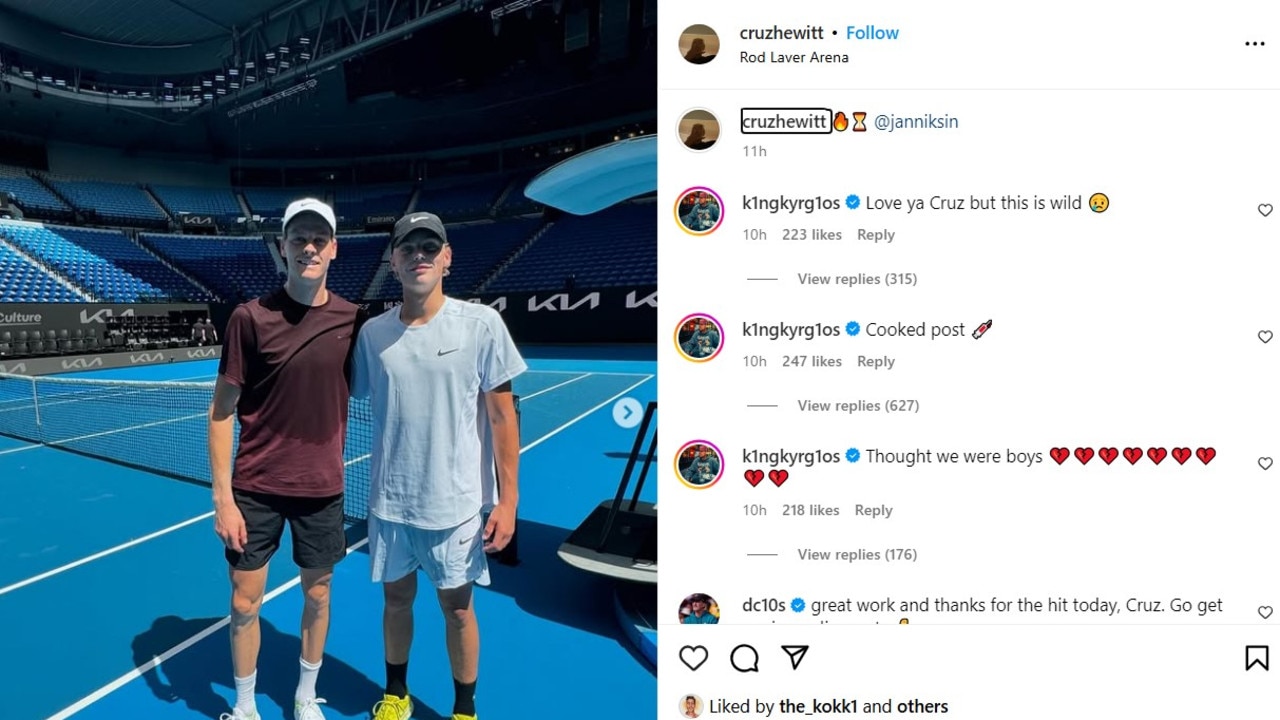Demon’s huge Aus Open boost as upset gifts Aussie golden chance at ending 10-year drought

- by Admin
- January 2, 2025

Alex de Minaur needs to make sure he sends Fabian Marozsan a Christmas card this year.
BOXING: INOUE VS GOODMAN | FRI 24 JAN 7PM AEDT | Australia’s Sam Goodman is set for a blockbuster fight against undefeated Naoya ‘The Monster’ Inoue in Tokyo | Order Now with Main Event on Kayo Sports.
An upset win by the 25-year-old Hungarian has handed de Minaur a huge Australian Open boost, giving him the best chance he’s ever had to make the quarter-finals and beyond.
The result came at the Hong Kong Open, where Marozsan stunned top seed and world No.8 Andrey Rublev in the Russian’s first match of the tournament, 7-5 3-6 6-3.
It means Rublev, who won the tournament in 2024 and was thus defending big ranking points, will fall a spot in the next ATP rankings with de Minaur taking his spot at No.8.
That’s despite Australia failing to make it out of the groups of the United Cup. De Minaur did his part, winning two matches against lesser opposition, and combined with Rublev’s early exit in Hong Kong that was enough to give the Aussie the ranking edge.
The next ATP rankings with de Minaur as the world No.8 will be released on Monday, and those will be used for the Australian Open seedings.
Crucially, being the No.8 seed at a grand slam means you cannot face a higher-ranked opponent until at least the quarter-finals. This is now de Minaur’s path.
Rather than being lined up to face a player seeded between No.17-24 in the third round, and a No.5-8 seed in the fourth round, as the No.8 seed himself de Minaur can only face a player seeded between No.25-32 in the third round, and a No.9-12 seed in the fourth round.
DE MINAUR’S MOCK PATH AT THE AUSTRALIAN OPEN AS NO.8 SEED
Based on live ATP rankings as of 12am January 3
Round 1: vs unseeded opponent
Round 2: vs unseeded opponent
Round 3: vs No.25-32 seed (Tomas Machac, Jiri Lehecka, Jordan Thompson, Sebastian Baez, Felix Auger-Aliassime, Francisco Cerundolo, Giovanni Mpetshi Perricard or Flavio Cobolli)
Round 4: vs No.9-12 seed (Andrey Rublev, Stefanos Tsitsipas, Grigor Dimitrov or Tommy Paul)
Quarter-final: vs No.1-4 seed (Jannik Sinner, Alex Zverev, Carlos Alcaraz or Taylor Fritz)
This does not make de Minaur’s draw easy, just theoretically easier.
Had he remained the No.9 seed, de Minaur would have been lined up against one of Novak Djokovic, Daniil Medvedev, Casper Ruud or Rublev in the fourth round instead, with Djokovic in particular clearly being a more difficult match-up than the options he now has.
De Minaur has never beaten a seeded player at the Australian Open, always progressing exactly as far as his own ranking said he should. For example, as the No.10 seed last year, de Minaur (ironically) lost to No.5 Rublev in the fourth round; that followed 2023’s defeat to No.4 Novak Djokovic, and 2022’s loss to No.11 Jannik Sinner.
After a career-best year, which saw de Minaur make the quarter-finals of the French Open, Wimbledon and US Open and move as high as No.6 in the world, he is hoping to become the first Australian male to make the quarter-finals at Melbourne Park since Nick Kyrgios in 2015.
Kyrgios unsure how wrist will hold up | 00:24
De Minaur will not be the only local hope on the men’s side, as for the first time since 1982, there will be three Aussie seeds in the men’s singles draw. As it stands, Alexei Popyrin will be seeded 24th, with Jordan Thompson 27th.
However Thompson, Jiri Lehecka (currently No.26) and big-serving French prodigy Giovanni Mpetshi Perricard (No.30) are still active in the Brisbane International and could move up further – while in the United Cup, Tomas Machac (No.25) and Flavio Cobolli (No.32) could earn more ranking points playing for Czechia and Italy respectively.
Machac and Cobolli play each other on Friday; Popyrin would drop out of the No.24 spot (and into a slightly harder portion of the Australian Open draw) if Machac wins.
How does a grand slam singles draw work?
The top 32 players in each singles draw are seeded, and placed throughout the bracket to ensure they cannot play each other until at least the third round (round of 32).
The draw ceremony begins with the qualifiers, wildcards and non-seeded main draw entrants being randomly placed throughout the draw, filling all spots which will not feature seeds.
The No.1 and No.2 seeds are placed on opposite sides of the draw, in the top left and bottom right of the bracket respectively.
The No.3 and No.4 seeds are randomly drawn into the other corners, to face the No.1 and/or No.2 in the semi-finals.
Then the No.5-8 seeds are placed, one in each quarter, to face a No.1-4 seed in the quarter-finals.
Then the No.9-12 seeds are placed, one in each section which features a No.5-8 seed, to face them in the fourth round.
Then the No.13-16 seeds are placed, one in each section which features a No.1-4 seed, to face them in the fourth round.
Then the No.17-24 seeds are placed, one in each mini-section which features a No.9-16 seed, to face them in the third round.
Finally the No.25-32 seeds are placed, one in each mini-section which features a No.1-8 seed, to face them in the third round.
The Latest News
-
January 4, 2025Australia v India: fifth men’s cricket Test, day three – live
-
January 4, 2025A massive Australian Open awaits, and I’m tipping a couple of first-time winners
-
January 4, 2025Flashback: Australia regain Ashes to kickstart decade of dominance | cricket.com.au
-
January 4, 2025Australian coach McDonald accuses India of intimidating Konstas
-
January 4, 2025‘Thought we were boys’: Kyrgios launches comment spree over ‘cooked’ Cruz Hewitt photo





